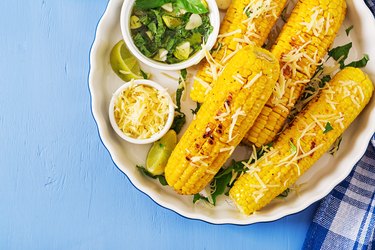
Hybrid foods are those that will not grow in nature. Hybrid beans and fruits are among the examples of those foods that are bred selectively rather than evolving over time in nature.
Tip
Hybrid foods must be taken care of by humans or they will succumb to pests, fungi or other environmental aggressors. Farmers benefit in that hybridized fruit plants can produce consistent, higher yields with predictable maturation times.
Video of the Day
Hybrid and GMO Foods Differences
Hybrid foods are those that are cross-bred to create produce that maximizes desirable traits. These include increased durability, production yield, size of the fruit or vegetable and improved taste. This is not a new process; in fact, the process has occurred for over 10,000 years.
Video of the Day
Hybrid food examples include bananas and Honeycrisp apples. A November 2013 study published in PLOS One suggested that crossbred or hybrid bananas are grown worldwide as a major economic and food resource in developing countries.
The Academy of Nutrition and Dietetics explains that hybrid foods don't use genetically modified organism (GMO) technology. Instead, hybrids use traditional pollination that can ordinarily occur in nature with controlled pollination techniques that enable the breeding of new generations of fruiting plants with desirable characteristics. This can lead to fruits and foods with uniform sizes and shapes, increased juiciness, improved taste and better nutrition.
Hybrid produce is created when two different varieties or types of a fruit or vegetable are cross-bred to create new varieties. A grapefruit, for example, is a hybrid fruit that was made from the cross-breeding of a pomelo and a sweet orange. This, however, does not mean it is a GMO food.
Read more: Examples of GMO Foods
Hybrid Foods Potential Benefits
GMO foods are ones that cannot occur by growing in nature or without traditional cross-breeding techniques that may interfere with the natural state of the food. The word genome is used to describe the genetic material present in every cell; adding foreign material such as transgenic DNA into the genome is the process that creates a GMO. By changing a single gene, it alters the entire organism.
There are hidden GMO foods that you may not even be aware of; those concerned should carefully read nutritional labels.The disadvantages of genetically modified foods may included an allergic reaction, according to a March 2013 study published in Annals of Agriculture and Environmental Medicine. The study also suggested that consuming GMOs may lead to an increased chance of developing tumors in the lungs, breasts or colon.
While there are some who believe there are these potential risks of GMO foods, hybrid foods are typically not quite as controversial or subject to such debate. In fact, hybrid foods may even be classified as USDA organic. Many such foods are thought to offer health benefits.
Examples of Hybrid Foods
An August 2014 study published in the Journal of Extension suggests that a comprehensive hybrid food preservation program increases the knowledge of food preservation, food safety and recommended food preservation techniques in a noticeable manner.
Examples of hybrid fruits include seedless apples, varieties of dates and kiwis, seedless pineapples, seedless citrus fruit, seedless grapes, seedless persimmons and seedless watermelons, among others. Common hybrid vegetables include beets, carrots, corn, potatoes, celery and cauliflower. Other hybrid foods are hybrid beans, nuts and seeds.
These may include cashews, almonds, oats, rice, wheat, wheat grass, soy, legumes and most beans. Hybrid herbs examples are goldenseal, ginseng, echinacea, chamomile, aloe vera, nutmeg, comfrey and garlic. To prevent any foods and/or supplements from wreaking havoc on your digestive system, be mindful, read labels and exercise caution when trying a new food or supplement for the very first time.
.
- Academy of Nutrition and Dietetics: "10 Must Know Hybrid Fruits"
- Journal of Extension: "Hybrid Food Preservation Program Improves Food Preservation and Food Safety Knowledge"
- Annals of Agriculture and Environmental Medicine: "Benefits and Risks Associated With Genetically Modified Food Products"
- PLOS One: "Origins and Domestication of Cultivated Banana Inferred From Chloroplast and Nuclear Genes"